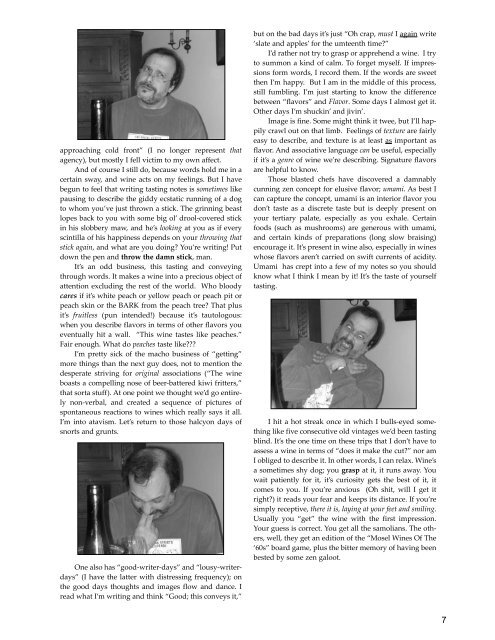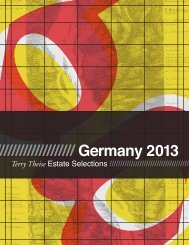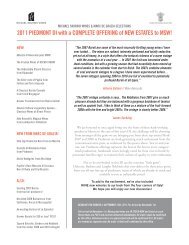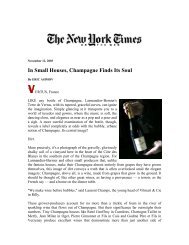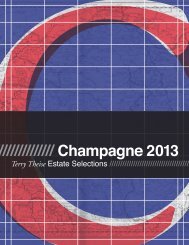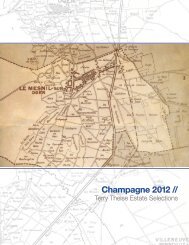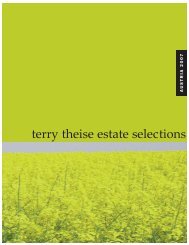German Catalog 2006 USE THIS ONE.qxp - Michael Skurnik Wines
German Catalog 2006 USE THIS ONE.qxp - Michael Skurnik Wines
German Catalog 2006 USE THIS ONE.qxp - Michael Skurnik Wines
You also want an ePaper? Increase the reach of your titles
YUMPU automatically turns print PDFs into web optimized ePapers that Google loves.
approaching cold front” (I no longer represent that<br />
agency), but mostly I fell victim to my own affect.<br />
And of course I still do, because words hold me in a<br />
certain sway, and wine acts on my feelings. But I have<br />
begun to feel that writing tasting notes is sometimes like<br />
pausing to describe the giddy ecstatic running of a dog<br />
to whom you’ve just thrown a stick. The grinning beast<br />
lopes back to you with some big ol’ drool-covered stick<br />
in his slobbery maw, and he’s looking at you as if every<br />
scintilla of his happiness depends on your throwing that<br />
stick again, and what are you doing? You’re writing! Put<br />
down the pen and throw the damn stick, man.<br />
It’s an odd business, this tasting and conveying<br />
through words. It makes a wine into a precious object of<br />
attention excluding the rest of the world. Who bloody<br />
cares if it’s white peach or yellow peach or peach pit or<br />
peach skin or the BARK from the peach tree? That plus<br />
it’s fruitless (pun intended!) because it’s tautologous:<br />
when you describe flavors in terms of other flavors you<br />
eventually hit a wall. “This wine tastes like peaches.”<br />
Fair enough. What do peaches taste like???<br />
I’m pretty sick of the macho business of “getting”<br />
more things than the next guy does, not to mention the<br />
desperate striving for original associations (“The wine<br />
boasts a compelling nose of beer-battered kiwi fritters,”<br />
that sorta stuff). At one point we thought we’d go entirely<br />
non-verbal, and created a sequence of pictures of<br />
spontaneous reactions to wines which really says it all.<br />
I’m into atavism. Let’s return to those halcyon days of<br />
snorts and grunts.<br />
One also has “good-writer-days” and “lousy-writerdays”<br />
(I have the latter with distressing frequency); on<br />
the good days thoughts and images flow and dance. I<br />
read what I’m writing and think “Good; this conveys it,”<br />
but on the bad days it’s just “Oh crap, must I again write<br />
‘slate and apples’ for the umteenth time?”<br />
I’d rather not try to grasp or apprehend a wine. I try<br />
to summon a kind of calm. To forget myself. If impressions<br />
form words, I record them. If the words are sweet<br />
then I’m happy. But I am in the middle of this process,<br />
still fumbling. I’m just starting to know the difference<br />
between “flavors” and Flavor. Some days I almost get it.<br />
Other days I’m shuckin’ and jivin’.<br />
Image is fine. Some might think it twee, but I’ll happily<br />
crawl out on that limb. Feelings of texture are fairly<br />
easy to describe, and texture is at least as important as<br />
flavor. And associative language can be useful, especially<br />
if it’s a genre of wine we’re describing. Signature flavors<br />
are helpful to know.<br />
Those blasted chefs have discovered a damnably<br />
cunning zen concept for elusive flavor; umami. As best I<br />
can capture the concept, umami is an interior flavor you<br />
don’t taste as a discrete taste but is deeply present on<br />
your tertiary palate, especially as you exhale. Certain<br />
foods (such as mushrooms) are generous with umami,<br />
and certain kinds of preparations (long slow braising)<br />
encourage it. It’s present in wine also, especially in wines<br />
whose flavors aren’t carried on swift currents of acidity.<br />
Umami has crept into a few of my notes so you should<br />
know what I think I mean by it! It’s the taste of yourself<br />
tasting.<br />
I hit a hot streak once in which I bulls-eyed something<br />
like five consecutive old vintages we’d been tasting<br />
blind. It’s the one time on these trips that I don’t have to<br />
assess a wine in terms of “does it make the cut?” nor am<br />
I obliged to describe it. In other words, I can relax. Wine’s<br />
a sometimes shy dog; you grasp at it, it runs away. You<br />
wait patiently for it, it’s curiosity gets the best of it, it<br />
comes to you. If you’re anxious (Oh shit, will I get it<br />
right?) it reads your fear and keeps its distance. If you’re<br />
simply receptive, there it is, laying at your feet and smiling.<br />
Usually you “get” the wine with the first impression.<br />
Your guess is correct. You get all the samolians. The others,<br />
well, they get an edition of the “Mosel <strong>Wines</strong> Of The<br />
‘60s” board game, plus the bitter memory of having been<br />
bested by some zen galoot.<br />
7


